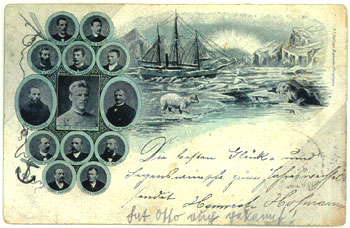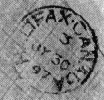|
|
The Government
of Canada declared its interest in including the Arctic Islands
within the Dominion on October 10, 1874. It was considered a
necessity due to the increasing entry of American explorers
and whalers. But it was not passed until November 4, 1879, and
with some reluctance noted, it declared ".
. . all British territories or possessions in North America,
not already included within the Dominion of Canada, and all
Islands adjacent to any such territories or possessions shall
forever (except Newfoundland and it's dependencies) be annexed
to the Dominion." The
British Government approved the order on July 31 and it took
effect October 9, 1880. On October 20, 1895, the Government
of Canada by another order-in-council constituted the provisional
districts of Ungava, Franklin, MacKenzie and Yukon.
Under the
command of Captain J.E. Bernier in 1904, the CGS ARCTIC
patrolled whaler activity in Hudsons Bay and established a divisional
police headquarters at Churchill. They wintered at Cape Fullerton
and continued the patrol the following year until ARCTIC
was ordered home for repairs in September.
|
First Canadian Hudsons
Bay Expedition
1884-85
|
|
A post card
to Dr. Robert Bell in 1885 recalls the problems faced after
setting up a study station at Ashe Point in Hudsons Bay. A recheck
of the station the following spring found Ashe had contracted
scurvy and required immediate medical attention. The card thanks
Bell for his help.
"October, 1885 ... I have changed
my address to 28 St. Amble Street, so that if you come down
to Quebec this winter look me up then -- Still sore and stiff,
but enjoying myself -- not raw potato however ..."
W.S.
Ashe
|
Second Canadian
Hudsons Bay Expedition
1885-86
|
|
During
preparations to put the expedition in the field, the Minister
of Marine and Fisheries wrote to recommend that Dr. Robert Bell
invite J.W. Tyrrell to join the crew of the ALERT.
Tyrrell was selected and became a leader of several later study
groups. |
Jackson-Harmsworth
Arctic Expedition
1894-97
|
|
To Study Franz Josef Land
for a Route to the North Pole . . .
One
of the few known pieces of mail (with letter dated 8 April
1895) from the British Jackson-Harmsworth North Polar exploring
expedition at Cape Flora, Franz Josef Land (that would save
and return Nansen from his perilous North Pole trek attempt),
bearing the expedition ship's S.Y. WINDWARD
vignette as well as the expedition's location hand stamp.
Uncanceled, it probably was returned on a British ship, being
courtesy delivered (common practice at that time) by a ship's
officer.
(Correspondence
courtesy of Herb & Janice Harvis)
|
|
|
The Jackson
Harmsworth Expedition conducted studies during 1894-97
and were preparing a dash to the pole when Nansen met them on
his own return from an attempt over the pack ice. On his advice
they suspended the plan.
A private
label was used on outgoing mail carried by the annual supply
ship. It was deposited at the first English port.
|
How Can the North
Polar Region be Crossed ?
|
|
 REVERSE SIDE
REVERSE SIDE
|
|
A solution
devised by Fridtjof Nansen to cross the previously unnavigable
polar icefields was tested in the design of the FRAM,
a boat of immense strength and unusual form. The bow and stern
were pointed, while the sides were sloped so the ice floes would
not crush, but slip under the ship and lift her.
The design
worked perfectly so that an ice party, consisting of Nansen
and Hjalmar Johansen, separated for almost a year, were able
to return to Norway in 1896 only a week apart. The entire party
was considered national heroes in their homeland.
|
Otto Sverdrup has Taken the FRAM
North
|
|
The
card commemorates the return of the FRAM from the
Nansen trip of 1896 and the writer added news of the new venture
under Sverdrup who defined the northern boundary of Greenland
during 1898-99. The FRAM, designed to resist ice
pressures, was an excellent scientific vessel. |
Canadian Geological Survey
1897
|
|
The Geological
Survey of Canada sailed from Halifax aboard the S.S. DIANA
in July, 1897, with Dr. Robert Bell leading this fourth expedition
to the Arctic Islands. Mail from his wife who was visiting in
Germany arrived late and was forwarded to the ship at Newfoundland.
The expedition work began at Ashe Inlet in Baffin Bay and collected
data on Arctic geology and flora.

The
square boxed Halifax cancellation served as the forwarding mark.
|
To Float Over the
Pole
1897
|
|
|
| Salamond
Andree
and two companions attempted to fly a balloon from Spitzbergen
to the North Pole in 1897. Their fate was unknown for thirty five
years until their remains were found on a small island within
300 miles of the starting point. They had perished attempting
to return on foot. |
| Mail
was not carried on the flight, but letters were posted
from the base camp by the balloonists and visitors. |
|
The Duke of Abruzzi
Brought Italy Into the Polar Quest
1899
|
The expedition
placed their vessel at a high latitude and made an attempt to
reach the North Pole by dog team during 1899.
Mail is
not known from the party during the field period, but commemorative
cards issued on their return were very popular.
|
(Exhibition pieces
courtesy of George Hall)
|